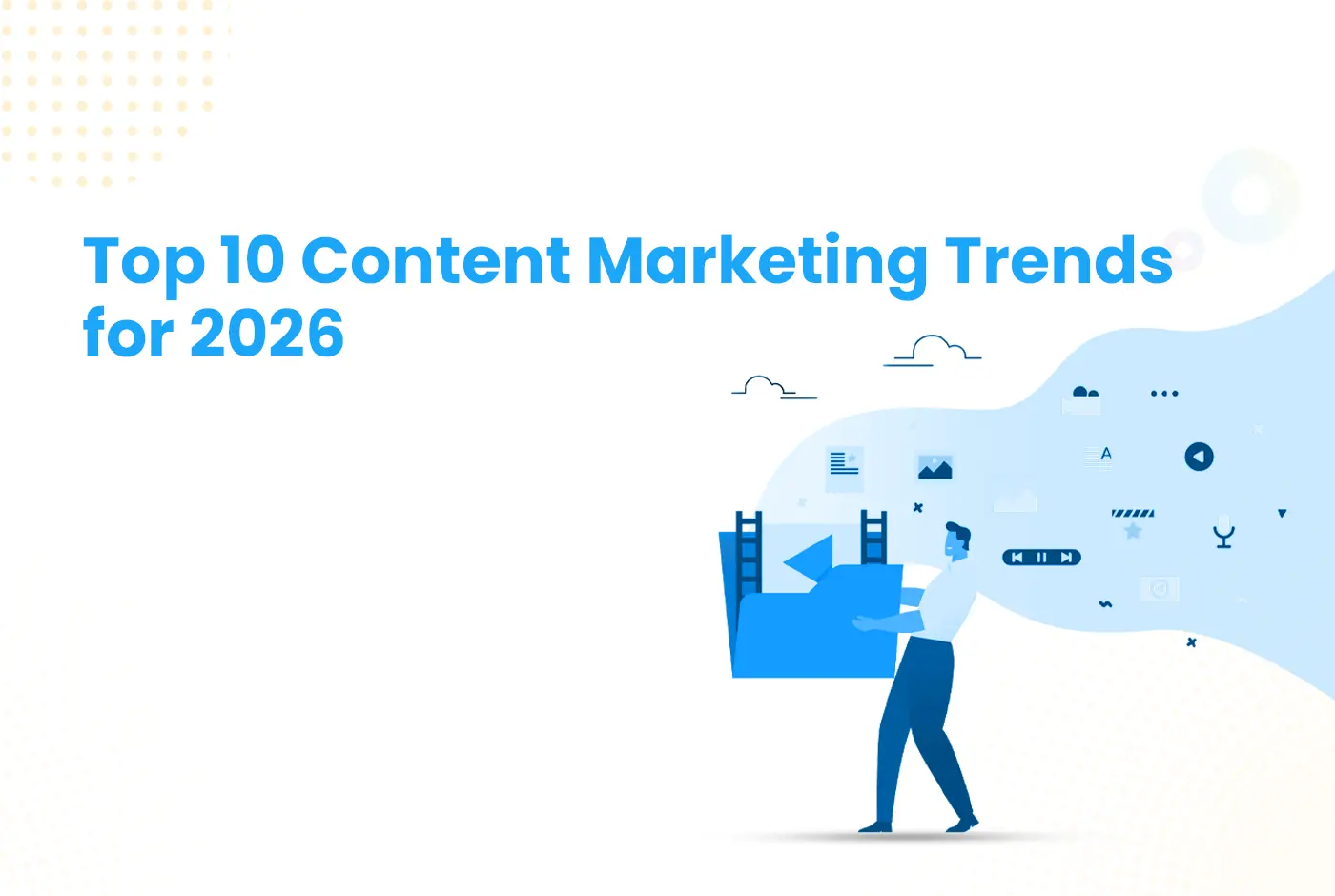Top 10 Content Marketing Trends for 2026

Listen to this article
Table of Contents
- AI-Driven Content Creation and Augmented Authoring
- Voice Search and Conversational Queries
- Formats That are Interactive and Immersive
- Strategy for "Zero-Click" Discovery
- Trust, Authority, & Original Insight
- Community & Owned Distribution vs. Being Dependent on Platforms
- Hyper-Personalization & Segmented Content
- Ethical AI & Responsible Content Governance
- Repurposing & Content Ecosystems
- Measuring What Matters - Signals vs Vanity Metrics
- How to Prepare Now
As we draw closer to 2026, content marketing is changing ever faster. AI advances, different search paradigms, changing audience habits, and the necessity for authenticity are all influencing how brands create, disseminate, and evaluate their content. To stay ahead of the curve, marketers will need to know the trends likely to shape content strategy in the coming year.
The following are ten content marketing trends that are likely to dominate in 2026.
1. AI-Driven Content Creation and Augmented Authoring
AI tools are now simply drafting tools, and in 2026 brands will utilize AI as co-authors, assistants, and quality filters. You can anticipate content creation platforms to continue to suggest structure, tone, subtopics, and data points, while human editors concentrate on strategy, voice, and supervisory roles. Content marketing agencies may turn into conductors of ideas rather than the sole creators of every draft.
2. Voice Search and Conversational Queries
As users speak to more devices and assistants, you will need to optimize your content for conversational language that sounds spoken. A query like "how do I fix my router" may soon become, “Hey Alexa, help me troubleshoot my router issues." That shift will call for content built to answer real, natural language questions, not just to discover keywords.
3. Formats That are Interactive and Immersive
Static content will play a less dominant role than interactive formats will. Quizzes, calculators, polls, AR/VR experiences, and interactive infographics will involve a deeper level of engagement than traditional blog posts will. Immersive content will not only be able to keep attention, but also help users personalize value from your brand's content.
4. Strategy for "Zero-Click" Discovery
Search is evolving from click-fed models into AI Assistants, widgets, knowledge graphs, and other means. Users will get answers to their questions without engaging with your website. Brands must optimize for snippets, structure content specifically for the featured answer, and craft content for those zero-click environments if they want to remain visible.
5. Trust, Authority, & Original Insight
The inundation of the web with AI-generated and formulaic content is leading audiences to put a higher value on authenticity, an independent viewpoint, and quantifiable authorship. In the content plan, content brands need to inject human voices, subject matter expertise, and brand ownership. Trust and authoritativeness will drive performance more than any SEO signals will over the long term.
6. Community & Owned Distribution vs. Being Dependent on Platforms
Brands will begin to lean heavily towards their first-party communities (Slack, Discord, membership communities) instead of leaning on their social platforms or search engines. Building community supports what a brand can own influence over the audience and get away from algorithmic limits.
7. Hyper-Personalization & Segmented Content
Generalized content no longer works. By 2026, brands will utilize first-party data to serve hyper-personalized experiences. Featuring, for example, dynamic content boxes, behavior, journey stage surveillance, and personalized content flows that yield greater relevance and conversion.
8. Ethical AI & Responsible Content Governance
As AI becomes mainstream in creation, there will be increased scrutiny for bias, fairness, and responsible outputs. Brands will need guardrails in place, including human review, mist checks, and explainable AI workflows. If brands publish misleading content, or fail to hold accountable content, they won't be long for losing trust.
9. Repurposing & Content Ecosystems
Content won't live alone anymore. Content will live as Ecosystems. For example, a long offer piece of content can then lead to micro videos, infographics, podcast episodes, snippets for social, and threads for email. Content ecosystems enhance exposure and establish consistency across formats.
10. Measuring What Matters - Signals vs Vanity Metrics
Clickthroughs and pageviews will become less relevant. In 2026, the majority of success metrics will start shifting to time-on-task metrics, conversions, content impact on leads, sentiment lift, and community engagement. Brands will be developing dashboards across content funnels that demonstrate content is producing real business results.
How to Prepare Now
- Audit your current stack - Include AI tools within reason that provide understanding and insights, not substitutes.
- Start building or nurturing private communities to create for owned reach.
- Train writers to write in interactive, conversational, and aware formats of UX.
- Create standards around content governance - particularly in areas around AI.
- Orient measurement around high value outcomes, not vanity metrics.
2026 will not be just another year in content marketing. It will signify that the system is changing in terms of the content being shaped by AI, trust, user control, and ecosystems that are strategic, using interactivity, authority, and audience ownership, that you will remember in 2026.
Take these ten trends with you, and use them as your possible playbook for what lies ahead, and create relationships with content now that don't get lost in the ongoing storm of change. Follow Finessse Interactive for excellence.
No related posts available.
